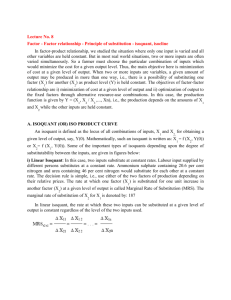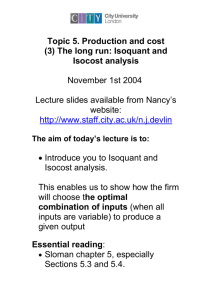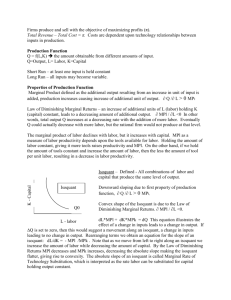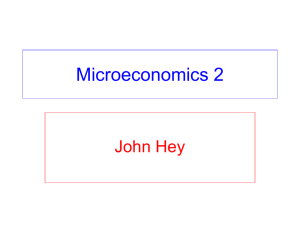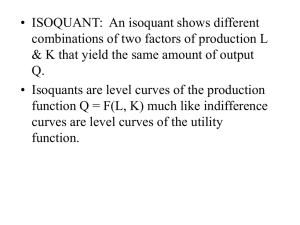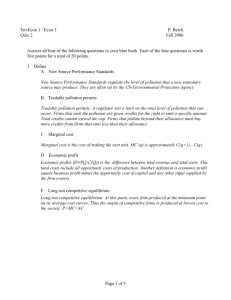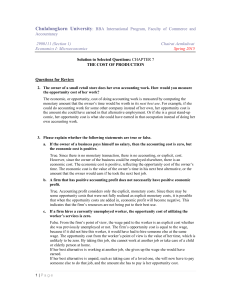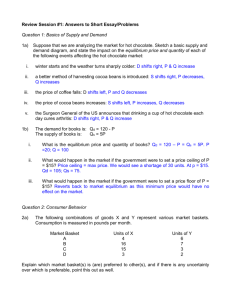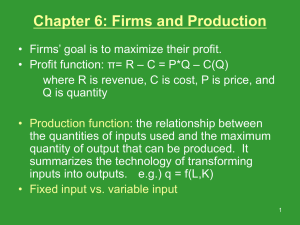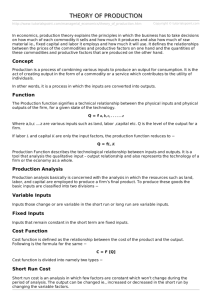User:Sadhana/Temp/Isoquant and isocost
advertisement
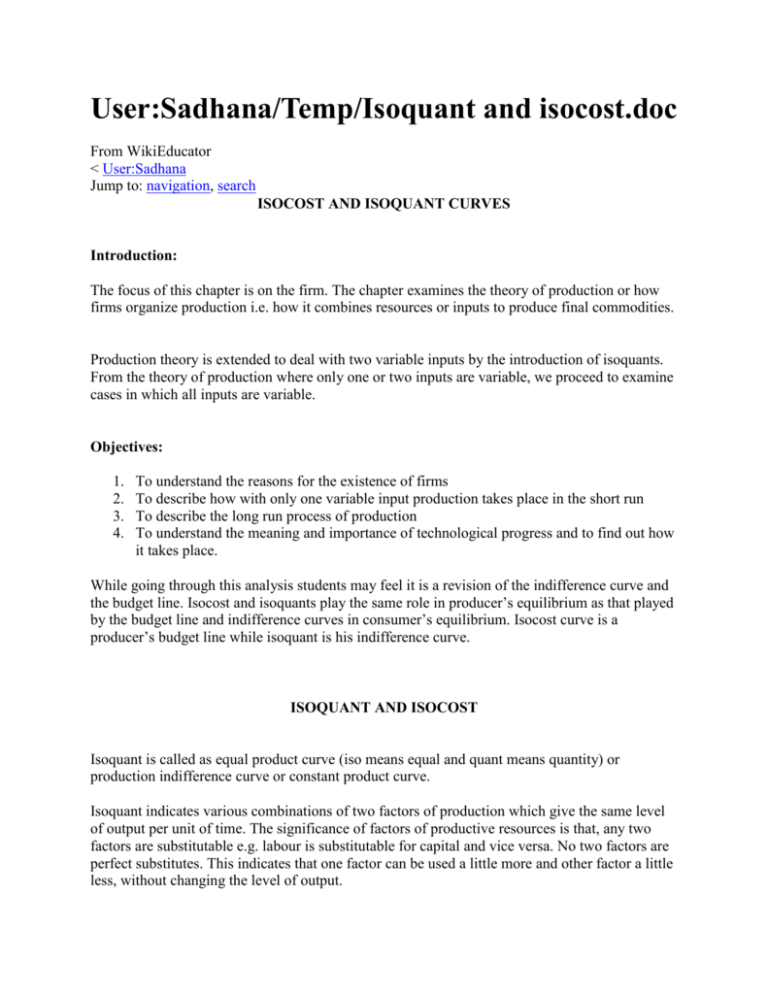
User:Sadhana/Temp/Isoquant and isocost.doc From WikiEducator < User:Sadhana Jump to: navigation, search ISOCOST AND ISOQUANT CURVES Introduction: The focus of this chapter is on the firm. The chapter examines the theory of production or how firms organize production i.e. how it combines resources or inputs to produce final commodities. Production theory is extended to deal with two variable inputs by the introduction of isoquants. From the theory of production where only one or two inputs are variable, we proceed to examine cases in which all inputs are variable. Objectives: 1. 2. 3. 4. To understand the reasons for the existence of firms To describe how with only one variable input production takes place in the short run To describe the long run process of production To understand the meaning and importance of technological progress and to find out how it takes place. While going through this analysis students may feel it is a revision of the indifference curve and the budget line. Isocost and isoquants play the same role in producer’s equilibrium as that played by the budget line and indifference curves in consumer’s equilibrium. Isocost curve is a producer’s budget line while isoquant is his indifference curve. ISOQUANT AND ISOCOST Isoquant is called as equal product curve (iso means equal and quant means quantity) or production indifference curve or constant product curve. Isoquant indicates various combinations of two factors of production which give the same level of output per unit of time. The significance of factors of productive resources is that, any two factors are substitutable e.g. labour is substitutable for capital and vice versa. No two factors are perfect substitutes. This indicates that one factor can be used a little more and other factor a little less, without changing the level of output. Assumptions: 1. 2. 3. 4. 5. There are two factor inputs labour and capital The proportions of factor are variable. Physical production conditions are given The Scale of operation is variable The state of technology remains constant Definition: Isoquant is a graphical representation of various combinations of inputs say Labour and capital which give an equal level of output per unit of time. Output produced by different combinations of Land K is say, Q, then Q=f (L, K) Just as we demonstrate the MRSxy in respect of indifference curves through hypothetical data, we demonstrate the Marginal Rate of Technical Substitution of factor L for K (MRTS L,K ) Isocost curves: Isocost curve is the locus traced out by various combinations of L and K, each of which costs the producer the same amount of money (C ) Differentiating equation with respect to L, we have dK/dL = -w/r This gives the slope of the producer’s budget line (isocost curve). Suppose the producer is employing two variable factors, namely labour (L) and capital (K). The price of one unit of labour is w and that of one unit of capital is r. A producer employing L units of labour and K units of capital would thus have to spend (w.L+r.K) by way if factor cost. This represents producer’s total cost C and is expressed as C= w.L + r.K Price of capital remaining the same, a fall in price of labour leads to an outward pivotal shift in the isocost line and a rise in it, to an inward pivotal shift in it. Fall and rise in the prices of both by the same proportion cause parallel outward and inward shifts in it respectively. Properties of Isoquants Isoquants, abbreviated as IQs, possess the same properties as those of the indifference curves. For the convenience of the students, we can state them as follows. 1. IQs never intersect the two axis 1. A higher IQ implies a higher level of output 1. IQs never intersect each other 1. IQs are never parallel to each other. Interspacing between them is least at het ends and maximum in the middle. 1. IQs are convex to the origin; convex isoquants possess continuous substitutability of K and L over a stretch. Beyond this stretch, K and L are not substitutable foe each other. 1. If Land K are perfect substitutes of each other, the IQ, called linear isoquant, is linear. A linear isoquant implies that either factor can be used in proportion. If isoquant ahs several linear segments separated by kinks, the isoquant is called kinked isoquant or activity analysis isoquant or linear programming isoquant. Such isoquants are used in linear programming. 1. If Land K are prefect complements to each other, the IQ is L-shaped. Such isoquant is known a input-output isoquant or Leontief isoquant. There is only one combination of L and K available for production. It is the corner point of L-shaped isoquant. 1. If marginal product of one of the two factors is zero, IQ is parallel to the axis on which the factor with zero marginal products is represented. 1. If one of the two factors has negative marginal product the IQ slopes upwards from left to right. 1. If both the factors have negative marginal products, the IQ is concave to the origin. 1. If the producer has a preference for a factor of production, the IQ is quasi linear. s 1. If the factors to be employed in whole numbers units only. The IQ is discontinuous. Two isoquants do not intersect each other: If isoquants intersect with each other then the conclusion will be as follows: At A combination employment of labour is OL1 and use of capital is OK1. But by employing OL1 and OK1 units of labour and capital respectively the output is 100 units as well as 200 units. This is incorrect conclusion. Hence two isoquants are non-intersecting. I Isoquants need not be not parallel to each other: The rate of substitution between two factors is not necessarily the same in all the isoquant schedules. Hence, the isoquant need not be parallel. No isoquant can touch either axis: If an isoquant touches either axis, it would mean the product is being produced with the help of wither capital or labour only. In fact this is not possible. Hence, isoquant should not touch either axis. Isoquant is oval in shape: Isoquants may have positive upward slopes in their ends. This indicates that a larger quantity of one factor is combined with a relatively smaller amount of another factor. In this sense the marginal productivity of the abundant factor may become negative and so the output will decline. For this reason the end portion are uneconomical or economically not viable. Certain points represent zero marginal productivity points of capital or labour. The ridge lines join these points. The area between the ridge lines are the economic region of production. The higher the level of isoquant more will be the output and lower the isoquant lesser will be output. Isoqouant schedule: An isoquant shows different combinations of laobur and capital required for producing 500 units of output. The following table shows a hypothetical isoquant schedule of a firm producing 500 units of a good. Combinations Units of capital Units of Labour Total Output A 45 (OK1) 1 (OL1) 5000 (IQ1) B 40 (OK2) 2 (OL2) 5000 (IQ1) C 36 (OK3) 3 (OL3) 5000 (IQ1) D 33 (OK4) 4 (OL4) 5000 (IQ1) E 31 (OK5) 5 (OL5) 5000 (IQ1) F 28 (OK6) 6 (OL6) 5000 (IQ1) The schedule can be illustrated graphically where labour units are measured along the x axis and capital units are measured on Y axis. IQ 1 is derived on the basis of isoquant schedule. The different points such as ABCD EF on the isoquant curve represent various combinations of two factors (say labour and capital) yielding the same level of output, per unit of time. Iso quant map: It is a set of isoquant curves. Is quant map implies a family of isoquant curves. A number of isoquants representing different level of output are known as an isoquant map. Each isoquant represent a different level of output. It also shows how output varies as factor input changes. A higher isoquant refers to a larger output while a lower isoquant refers to a smaller output. Marginal Rate of Technical Substitution (MRTS) The concept of marginal rate of technical substitution in the theory of production is similar to the concept of marginal rate of substitution in the theory of consumption. The marginal rate of technical substitution refers to the rate of which one factor (labour) is substituted for another factor (capital) along an isoquant curve i.e. without changing the level of output. The principle of diminishing marginal rate of technical substitution (DMRTS), implies that the rate of substituting one factor for another factor diminishes as more and more units of one factor are substituted for another factor. The slope of isoquant curve measures the marginal rate of technical substitution. MRTSlk= K/L Constant MRTS: where isoquatn is straight line to the origin and unrealistic Increasing MRTS: isoqunat is concave to the origin and unrealistic Diminishing MRTS: isoquant is convex to the origin and realistic. Producer’s equilibrium or least cost combination: Assumptions 1. 2. 3. 4. 5. 6. There are two factors viz. labour and capital All units of labour and capital are homogenous The factor prices are given and constant The cost outlay (total cost) is given There is perfect competition in factor market A firm should be rational The producer’s equilibrium point is that where the isoquant is tangent to an iso cost line. By definition it is clear that to find out the producer’s equilibrium point, it is necessary to know something about the isocost line. Isocost line is a graphical representation of various combinations of the two factors that can be purchased by a firm form a given outlay and factor prices e.g. suppose the given total outlay is 500 which is to be spent on two factors say capital and labour. Summary: An isoquant shows the various combination of two inputs that can be used to produce a specific level of output. From the isoquant map, we can generate the total product curve of each input by holding the quantity of the other input constant. Isoquants are negatively sloped in the economically relevant range, convex to the origin and do not intersect. The absolute value of the slope of Isoquant is called the Marginal Rate of Technical Substitution. This equals the ratio of marginal productivity of two inputs. As we move down along an isoquant the absolute value of its slope or Marginal Rate of Technical Substitution declines and the isoquant is convex. Ridge lines separate the relevant (i.e. the negatively sloped) from the irrelevant (or positively sloped) portion of the isoquant. With right angled or L shaped, isoquant , inputs can only be combined in fixed proportion in production. Key Terms: Marginal Rate of Technical Substitution: Ridge lines Case study: The table given below indicate corresponding values for amount of labour (L) and capital(K) used by firm and the corresponding maximum quantities of output, which can be produced. Units of 7 70 140 210 280 350 420 490 capital 6 5 4 3 2 1 0 60 120 180 240 300 360 420 50 100 150 200 250 300 350 40 80 120 160 200 240 280 30 60 90 120 150 180 210 20 40 60 80 100 120 140 10 20 30 40 50 60 70 1 2 3 4 5 6 7 Units of labour 1. Draw isoquants at output level 60 units, 120 units 2. If price of capital per unit s 100 and labour is 500 draw isocost at 60 unts ofo output and 120 units of output 3. Find out the least cost factor combination at the output level 60 units and 120 units. The shape of isoquants: This section we examine the characteristics of isoquants, define the economic region of production and consider the special cases where the commodities can only be produced with fixed income combination. We can see that the shape of isoquant plays an important a role in the production theory as the shape of indifference curve in the consumption theory. Characteristics of isoquants These are crucial to understanding production theory with two variable inputs. Isoquants are similar to indifference curves. However, indifference curves shows various combinations of two commodities that provides the consumer equal level of satisfaction (measured ordinally), an isoquant shows the various combinations of two inputs that give the same level of output. Isoquants are negatively sloping in the economically relevant range. If the firm wants to reduce the quantity of capital used in production, it must increase the quantity of labour in order to continue to produce the same level of output. Economic region of production: The firm would not operate on the positively sloped portion of an isoquant because it could produce the same level of quantity with less capital and labour. Economic region of Production: The firm would not operate on the positively sloped portion of an isoquant because it could produce The same level of output with less capital and less labour. Ridge lines: separate the relevant (i.e. negatively sloped) from the irrelevant (or the positively sloped) portion of the isoquant. Ridge lines joins points on the various isoquants where the isoquants have zero slope (and thus zero MRTSlk) . Retrieved from "http://wikieducator.org/index.php?title=User:Sadhana/Temp/Isoquant_and_isocost.doc&oldid= 721850" Navigation menu Personal tools Log in Request account Namespaces User page Discussion Variants Views Read View source View history Actions Search Search Go Navigation Main Page Recent changes Help Practice editing Community Community portal Web chat Mailing list Print/export Create a book Download as PDF Printable version Tools What links here Related changes User contributions Logs Upload file Special pages Permanent link Page information This page was last modified on 17 October 2011, at 05:08. This page has been accessed 743 times. Content is available under the Creative Commons Attribution Share Alike License unless otherwise noted. Privacy policy About WikiEducator Disclaimers
